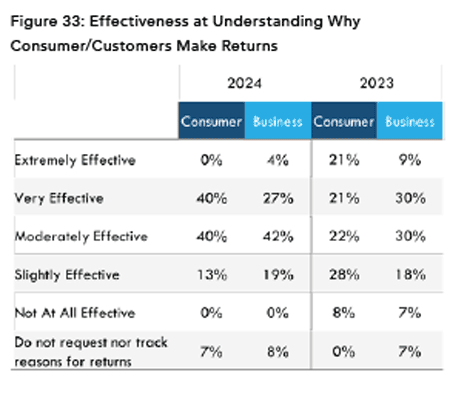Two weeks ago, I published my initial review and comment on the 2023/24 3PL Study, now in its amazing 27th year, all under the leadership of my friend Dr. John Langley of Penn State.
The report was released at the CSCMP Edge conference this Fall in Orlando. (See State of the 3PL Union 2023.)
Gilmore Says.... |
 |
| The report notes that “Before the pandemic, just-in-time supply chains predominated. Now, resiliency, agility and flexibility have become cornerstone principles.” |
 |
What do you say? |
|
| Click here to send us your comments |
| |
|
|
|
Last week, I summarized a few of the“focus topics” after the review of the core survey data and a discussion of the general state of shipper-3PL relationships. (See State of the 3PL Union 2023 Part 2.)
As promised last week, I will cover a few more special topics, along with offer some modest concerns about the report's direction.
Back from coverage last year was a special focus section on reverse logistics. The report notes that the process is hard, and the scope is increasing given the general growth of ecommerce sales in recent years that generate a high percentage of returns.
The report quotes Tony Sciarrotta, executive director of the Reverse Logistics Association, as saying that that in “76% of cases, consumers will say the returned product didn’t meet expectations, which leads to the fact that we have all of these products coming back that work and have nothing wrong.”
He adds that the end goal is to reduce or eliminate the need for reverse logistics.
“We need to stop returns. We need to make customers and consumers happier with what they buy,” Sciarrotta says, adding that “We have to make sure the sizes are right, the products are easy to use, and descriptions are accurate.”
Is that goal even remotely plausible?
No, but there may be progress in this area, with the responses to a question in the report survey about how well companies understand that reasons for returns showing improved insight, with 41% of consumer companies saying they have become very effective at that insight, versus 21% in last year's study, as shown in the graphic below:

Source: 3PL Study
As some additional data points in this section, the report says less than half of consumer-focused shippers (44%) self-identified their reverse logistics capabilities as strong or very strong. Just 24% of business-focused shippers ranked their capabilities as in one of those two categories.
In another follow up from last year is a section on the popular topic of “talent management” in the supply chain.
In terms of workers on the warehouse floor, Kim Curley, vice president of people and organization consulting at NTT DATA, says that “You need to offer thorough training where you’re really teaching people how to be good at their jobs from day one,” adding that “A lot of workers are dropped into the mix before they know how to do their jobs and have a less than positive experience in their first 30 to 90 days. By offering more mentoring on the floor — helping new hires be successful earlier — you’ll create more stickiness.”
The rest of this section was not very noteworthy.
I was interested in the section on “The Balance Between Efficiency and Resiliency,” because as I have noted before the pendulum in recent years, stemming from all the pandemic-induced supply chain disruptions, has swung in my view too far in the direction of resilience, and not enough on its costs. Not all resilience is worth the price to achieve it.
Along those lines, the report notes that “Before the pandemic, just-in-time supply chains predominated. Now, resiliency, agility and flexibility have become cornerstone principles.”
The report sees this shift as creating market opportunities for 3PLs, which I suppose is probably correct.
I was hoping the report would get into some depth about how you manage the trade-off between efficiency and resilience over time, but we didn’t get that.
What the report did discuss are what it said are the four critical components at play when trying to strike a balance between resiliency and efficiency. They are:
Inventory: In today’s operating environment, inventory is volatile and expensive. For each SKU, what is the efficiency-resiliency balance?
Visibility: “I’d rather have good visibility than piles of inventory,” says former supply chain exec and now consultant Kevin Smith. “If I know where it is, I’m in a better position than someone who stockpiles.”
Alternative Supply Sources: The report says that “Multi-sourcing can help shippers avoid the risk associated with a single source.” I’ll note that while that is generally true, that flexibility at the end usually comes at a cost from splitting volumes.
Network Optimization: It’s a good thing the report says. I generally agree, but would like to have seen more on how it is used to balance efficiency and resilience.
Surprisingly, there appears to have been no survey questions and thus data charts for this section, so we don’t know what shippers and 3PLs are thinking about this the efficiency trade-off curve.
There is a lot of material in this report – too much so I believe. I am not sure we need 75 pages worth. That said, it is an essential read in my opinion for both 3PLs and users of 3PLs.
But in recent years, especially this version, the report is starting to come across as much as a marketing document as a study. I hope the team reverses that trend in next year's report.
Am I off base or not? Let me know.
The report can be downloaded here: 2024 3PL Study
Any reaction to this data from the 3PL report - or Gilmore's critique? Let us know your thoughts at the Feedback section below.
Your Comments/Feedback
|